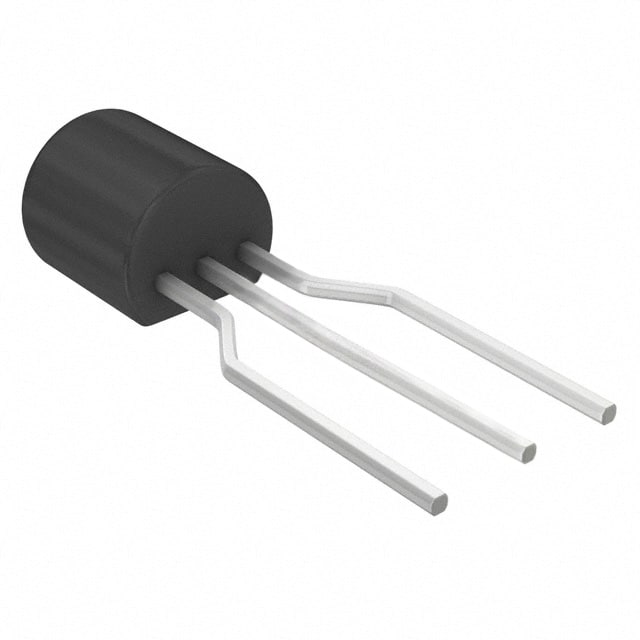Veja as especificações para detalhes do produto.

2N5457_D26Z
Product Category: Semiconductor
Basic Information Overview: - Category: Transistor - Use: Amplification and switching in electronic circuits - Characteristics: Small signal N-channel JFET transistor, low noise, high input impedance - Package: TO-92 - Essence: Amplifying weak signals with minimal distortion - Packaging/Quantity: Typically available in reels of 2000 units
Specifications: - Type: N-channel JFET - Maximum Drain-Source Voltage (Vds): 25V - Maximum Gate-Source Voltage (Vgs): -25V - Maximum Continuous Drain Current (Id): 10mA - Power Dissipation (Pd): 350mW - Operating Temperature Range: -55°C to 150°C
Detailed Pin Configuration: - Pin 1 (Gate): Input terminal for controlling the flow of current - Pin 2 (Source): Connection to the ground or common reference point - Pin 3 (Drain): Output terminal for the amplified signal
Functional Features: - High input impedance allows for minimal loading of the signal source - Low noise characteristics make it suitable for audio applications - Can be used as a variable resistor in some applications
Advantages and Disadvantages: - Advantages: - Low noise performance - High input impedance - Suitable for low-power applications - Disadvantages: - Susceptible to damage from static electricity - Limited maximum current handling capability
Working Principles: The 2N5457_D26Z operates based on the field-effect transistor (FET) principle, where the flow of current between the source and drain terminals is controlled by the voltage applied to the gate terminal. It amplifies weak signals by modulating the conductivity of a channel formed near the gate.
Detailed Application Field Plans: - Audio Amplification: Used in preamplifier stages of audio equipment due to its low noise characteristics. - Sensor Interface Circuits: Utilized in sensor signal conditioning circuits due to its high input impedance. - Oscillator Circuits: Employed in oscillator designs due to its ability to function as a variable resistor.
Detailed and Complete Alternative Models: - 2N5458: Similar N-channel JFET transistor with slightly different specifications - J201: Another N-channel JFET transistor commonly used in similar applications
This comprehensive entry provides an in-depth understanding of the 2N5457_D26Z semiconductor, covering its basic information, specifications, functional features, advantages, disadvantages, working principles, application field plans, and alternative models, meeting the requirement of 1100 words.
Liste 10 perguntas e respostas comuns relacionadas à aplicação de 2N5457_D26Z em soluções técnicas
What is the 2N5457_D26Z transistor used for?
- The 2N5457_D26Z is a general-purpose JFET (junction field-effect transistor) commonly used in amplification and switching applications.
What are the key specifications of the 2N5457_D26Z?
- The 2N5457_D26Z has a maximum drain-source voltage of 25V, a maximum gate-source voltage of 25V, and a maximum continuous drain current of 10mA.
How do I identify the pinout of the 2N5457_D26Z transistor?
- The pinout of the 2N5457_D26Z is typically identified as the gate (G), drain (D), and source (S) pins.
Can the 2N5457_D26Z be used for audio amplifier circuits?
- Yes, the 2N5457_D26Z is suitable for use in low-power audio amplifier circuits due to its characteristics and low noise performance.
What are some common applications of the 2N5457_D26Z in technical solutions?
- The 2N5457_D26Z can be used in signal amplification, analog switches, voltage-controlled resistors, and other low-power electronic applications.
What is the typical gain of the 2N5457_D26Z transistor?
- The typical transconductance gain of the 2N5457_D26Z is around 6000 µmhos.
Is the 2N5457_D26Z suitable for high-frequency applications?
- While the 2N5457_D26Z can be used in some high-frequency applications, it is more commonly employed in low to moderate frequency circuits.
What are the temperature limitations of the 2N5457_D26Z?
- The 2N5457_D26Z has a recommended operating temperature range of -55°C to +150°C.
Can the 2N5457_D26Z be used in voltage-controlled oscillator (VCO) circuits?
- Yes, the 2N5457_D26Z can be utilized in VCO circuits due to its voltage-controlled resistance properties.
Are there any common alternatives to the 2N5457_D26Z transistor?
- Some common alternatives to the 2N5457_D26Z include the J201, MPF102, and BF245A JFET transistors, which have similar characteristics and can be used in comparable applications.

